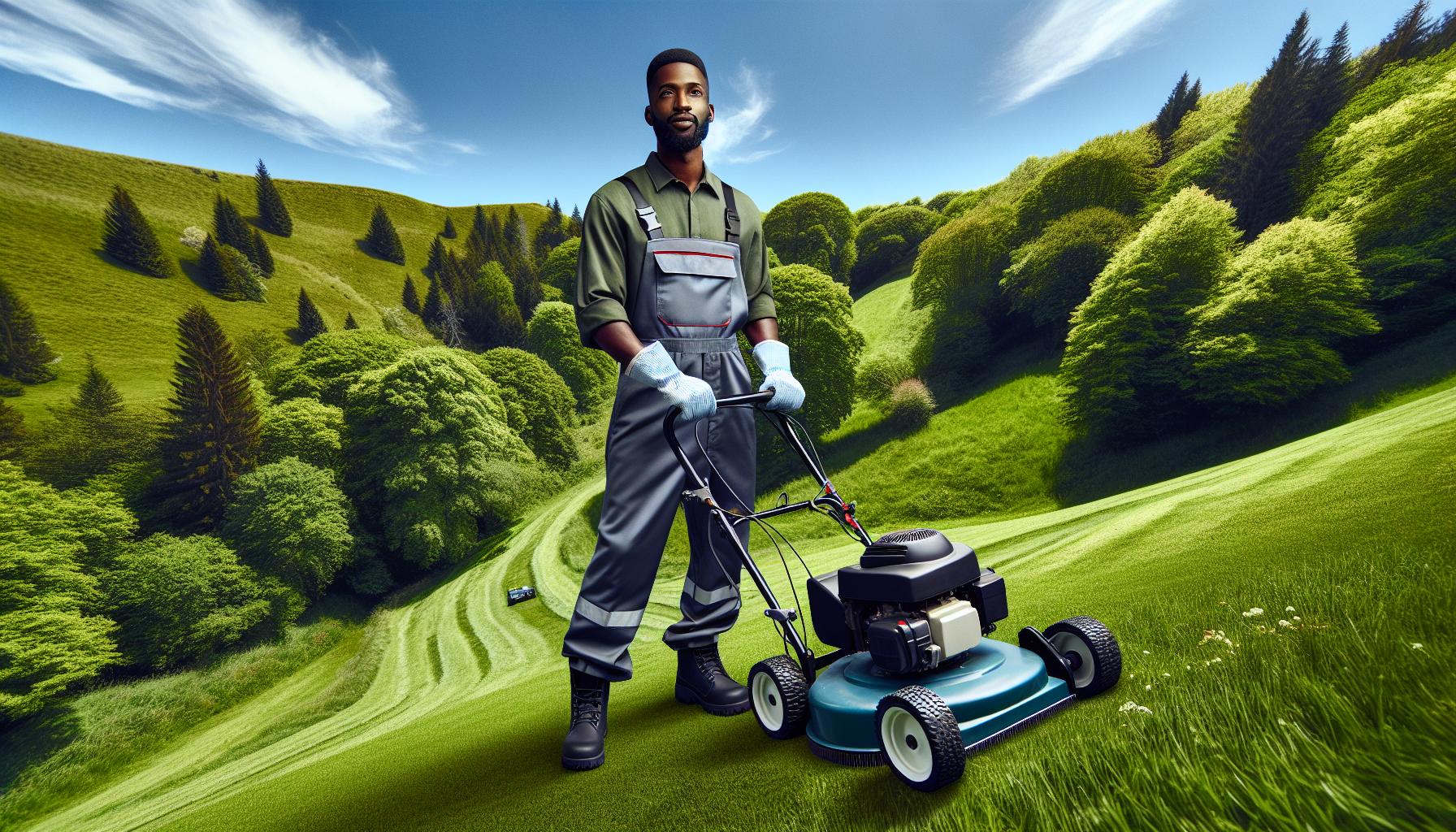Mowing steep hills and inclines can be a daunting task, but it doesn’t have to be dangerous. With the right safety tips, anyone can tackle these challenging terrains while minimizing risks. This article covers essential precautions and techniques to ensure a safe and efficient mowing experience, making yard work easier and worry-free.
Understanding the Risks
Mowing steep hills and inclines presents specific risks that individuals must recognize. Awareness of these potential hazards enhances safety and promotes cautious behavior during lawn care tasks.
Potential Hazards
- Slipping: Wet or uneven surfaces increase the risk of slipping, which can lead to falls.
- Rollovers: Operating a mower on steep inclines may result in rollover accidents, especially with riding mowers.
- Injury from Equipment: Contact with moving parts during use can cause cuts or bruises.
- Fatigue: Mowing on slopes requires more physical exertion, leading to fatigue that can impair judgment and control.
- Obstacles: Hidden rocks, roots, or other debris can pose threats when managing uneven terrain.
- Preventing Accidents: Implementing safety measures significantly lowers the risk of accidents and injuries.
- Using Proper Equipment: Selecting the right mower for hilly terrain enhances stability and control.
- Wearing Protective Gear: Proper footwear, gloves, and eye protection reduce the likelihood of injury.
- Maintaining Focus: Staying alert and avoiding distractions ensures better decision-making during mowing tasks.
- Plan of Action: Setting clear mowing paths and procedures helps to navigate slopes effectively, improving safety and efficiency.
Preparing for the Task

Proper preparation is crucial for safely mowing steep hills and inclines. Taking the time to select the right equipment and wear appropriate gear decreases the risk of accidents and promotes an efficient mowing process.
Choosing the Right Equipment
Selecting suitable equipment for mowing steep slopes is essential. Push mowers work best on small, manageable areas, while options like an rc lawn mower or riding mower can provide more control and efficiency on larger, challenging terrains. Consider the following equipment options:
- Self-Propelled Mowers: These mowers provide necessary traction and make it easier to control speed and direction on inclines.
- Zero-Turn Mowers: Designed for operating more efficiently on uneven terrain, zero-turn mowers can navigate around obstacles with ease.
- Trimmers and Edgers: For precise work along the edges, trimmers and edgers are helpful in tight spots and can improve the finished appearance.
Before mowing, inspect equipment for proper functionality, such as checking blade sharpness and ensuring all safety features are operational.
Wearing Appropriate Gear
Dressing appropriately for mowing steep hills enhances safety and comfort. Key considerations include:
- Non-Slip Footwear: Shoes with good grip reduce the risk of slipping on inclines or uneven ground.
- Protective Clothing: Long pants and sleeves protect exposed skin from debris and injuries while mowing.
- Gloves: Wearing gloves enhances grip on equipment and protects hands from vibration and potential cuts.
- Hearing Protection: Using earplugs or earmuffs prevents hearing damage from loud machinery, especially when mowing for extended periods.
By preparing adequately and using the right gear, individuals can tackle steep mowing tasks safely and effectively.
Mowing Techniques
Effective mowing techniques are essential for safely managing steep hills and inclines. Practicing the right techniques minimizes the risk of accidents and ensures thorough lawn care.
Proper Body Positioning
Maintaining the correct body position while mowing enhances stability and control. Stand upright with feet shoulder-width apart for balance. Shift weight slightly forward to prevent slipping. Keep arms relaxed and grip the mower handle firmly but comfortably to maintain control. Bend knees slightly. Move deliberately and avoid sudden movements. Following these techniques decreases the likelihood of losing balance and improves overall mowing efficiency.
Utilizing the Right Mowing Patterns
Choosing appropriate mowing patterns can help navigate inclines safely. Use horizontal stripes on steeper slopes instead of vertical ones to reduce the risk of tipping. Start at the bottom of the incline and work upward in straight lines. This method helps maintain traction and minimizes the chance of slipping. For less steep areas, zigzag patterns can improve coverage without compromising stability. Combining these techniques ensures a thorough and safe mowing experience on hilly terrain.
Post-Mowing Safety
Post-mowing safety is crucial for maintaining a secure environment after completing the task. Following some simple checks and processes ensures that all equipment is safely stored and potential hazards are minimized.
Inspecting the Area
Inspect the area for any hidden hazards or debris left behind after mowing. Look for items such as stones, branches, or equipment that might pose a risk to pedestrians or pets. Ensure that the ground is even and free of any leftover grass clippings, which could create slipping hazards if wet. Additionally, verify that all tools and equipment are accounted for and functioning correctly before use in the future.
Storing Equipment Properly
Store mowing equipment in a safe, dry place after use. Ensure that all power tools are turned off and cooled down before putting them away. Use a designated area, such as a shed or garage, to keep equipment organized and out of reach of children and pets. When possible, improve riding mowers on flat surfaces to prevent rolling. Always follow the manufacturer’s guidelines for maintenance and storage procedures to extend the lifespan of the equipment and ensure safety when it’s next needed.
Conclusion
Mowing steep hills and inclines doesn’t have to be a daunting task. By prioritizing safety and employing the right techniques individuals can navigate these challenging terrains with confidence. Proper equipment selection and protective gear play a crucial role in minimizing risks.
Maintaining focus and planning mowing paths effectively can prevent accidents and improve efficiency. After mowing it’s essential to inspect the area and store equipment safely to ensure a secure environment. By adhering to these essential safety tips individuals can enjoy a successful mowing experience while protecting themselves and their surroundings.
Frequently Asked Questions
What are the main risks of mowing steep hills?
Mowing steep hills poses several risks, including slipping on wet or uneven surfaces, rollover accidents with riding mowers, and injuries from equipment. Fatigue can also affect judgment, increasing the chance of accidents. Hidden obstacles may further complicate the mowing process, so it’s essential to be aware of these dangers.
How can I prepare for mowing steep hills safely?
To prepare for mowing steep hills safely, select the right equipment, such as self-propelled or zero-turn mowers, and wear appropriate clothing, including non-slip footwear and protective gear. Having a clear plan of action and assessing the area for hazards before mowing can significantly reduce risks.
What equipment is best for mowing steep hills?
For mowing steep hills, self-propelled mowers offer better traction, while zero-turn mowers are great for navigating uneven terrain. Trimmers are also useful for precision work along edges. Choosing the right equipment enhances safety and effectiveness on inclines.
What protective gear should I wear when mowing?
When mowing steep areas, wear non-slip footwear, protective clothing, gloves, and hearing protection. This gear helps prevent injuries and ensures comfort during the mowing process, allowing you to focus on maintaining safety.
What mowing techniques are best for hills?
For safely managing steep hills, maintain a proper body position by standing upright and keeping your feet shoulder-width apart. Use mowing patterns like horizontal stripes for steeper slopes and zigzag patterns for less steep areas, ensuring better coverage and stability.
How can I ensure safety after mowing?
Post-mowing safety involves inspecting the area for hidden hazards and ensuring the ground is clear of grass clippings and debris. Store equipment securely in a dry place to extend its lifespan and prevent access by children or pets.

